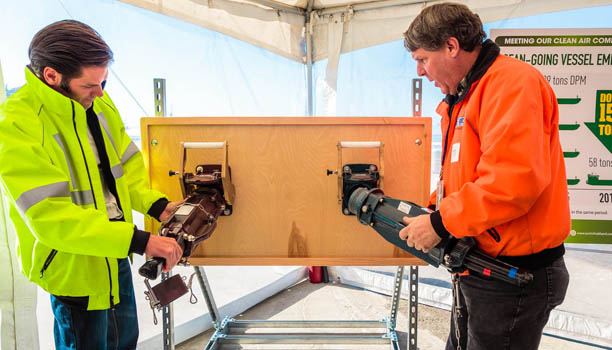The Bay Area can easily lay claim to being the epicenter for supply chain sustainability, with scores of companies here united in a mission to make transportation cleaner and more efficient.

A shore-to-ship connection, demonstrated here by Port of Oakland employees, provides electrical power to vessels, significantly reducing diesel and other air pollutant emissions from ships while they are at berth. Photo courtesy of the Port of Oakland
By Patrick Burnson
Published: December, 2013
The Bay Area can easily lay claim to being the epicenter for supply chain sustainability, with scores of companies here united in a mission to make transportation cleaner and more efficient.
The most recent example of this collaborative effort took place in San Francisco last month when BSR staged its annual global conference. For logistics managers, the highlight of the event was BSR’s Clean Cargo Working Group (CCWG) session, which provided an update on ocean carrier performance and environmental compliance.
Container carriers have been reporting their CO2 performance to shippers in a credible and comparable format, based on the CCWG CO2 methodology—the only existing and broadly recognized industry standard for container shipping—for the past five years. This reporting and dialogue enables shippers to calculate the environmental impacts of transporting goods around the world and to benchmark carriers’ performance.
Having this information helps multinationals like Nike, Heineken and Wal-Mart make informed buying decisions in their supply chains. CCWG also consistently engages in dialogue with other initiatives and experts working on these issues in the global transport industry to align approaches that can improve information sharing and performance for shippers and cargo carriers across the full transport supply chain.
Matson Announces Two New Green Vessels
Among the many carrier members of CCWG is Matson Navigation Company, headquartered in Oakland. This storied and iconic carrier recently announced that it has signed a contract with Aker Philadelphia Shipyard to build two new "clean" vessels for the transpacific trade.
The 3,600 twenty-foot equivalent unit (TEU) containerships will be equipped with dual-fuel engines that have liquefied natural gas capability and are expected to be delivered in the third and fourth quarters of 2018. Matson also announced that the first of the two new ships will be named after the late Senator Daniel K. Inouye, who was a longstanding supporter of the U.S. maritime industry and its role in supporting Hawaii’s economy.
The 850-foot long vessels will be the largest Jones Act containerships ever constructed and are designed to operate at speeds in excess of 23 knots, ensuring timely delivery of goods in Hawaii. Importantly, the ships will also be able to navigate safely into some of Hawaii’s smaller ports.
The new vessels will incorporate a number of green features such as a fuel- efficient hull design, dual-fuel engines, environmentally safe double-hull fuel tanks and fresh-water ballast systems. Matson executives told Pacific Rim Report that these state-of-the-art advancements are important to Hawaii as a means to reduce fuel consumption, resulting in significant emission reductions over time in its "home trade."
Port of Oakland Advances Shore Power Project
The Port of Oakland has made some green advances of its own, having just completed its shore power infrastructure project. This innovative shore-to-ship connection provides electrical power to vessels, thereby significantly reducing diesel and other air pollutant emissions from ships while they are at berth.
Shore power at the Port of Oakland is a two-phase, multi-year program covering 11 berths. The port has completed construction of its new electrical infrastructure system, and final testing of the new system is scheduled to be finished this month.
It’s important to note that the Port of Oakland took on the cost and burden of installing a shore power system to assist its stakeholders. The financial and operational challenge of complying with California’s new regulations to dramatically reduce air pollutant emissions is massive. But Bay Area residents can now be assured that logistics providers not only bring jobs and investment to the region, but also set a new standard of corporate citizenship.

